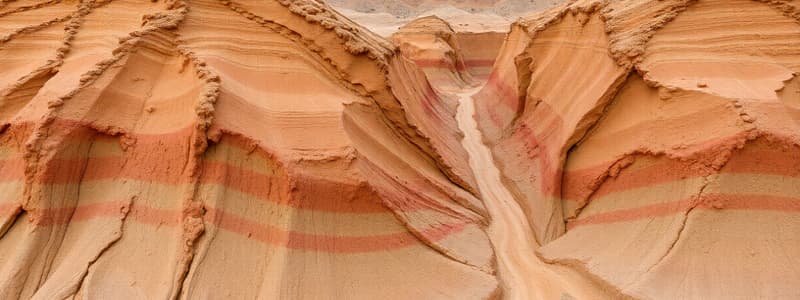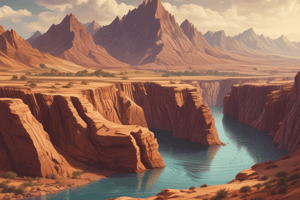Podcast
Questions and Answers
What is the process called when sheets of outer rock peel off due to expansion?
What is the process called when sheets of outer rock peel off due to expansion?
- Oxidation
- Salt wedging
- Exfoliation (correct)
- Frost action
Which type of weathering primarily shapes karst landscapes?
Which type of weathering primarily shapes karst landscapes?
- Chemical (correct)
- Thermal
- Mechanical
- Biological
Which gas plays a significant role in the dissolution of rocks in karst formations?
Which gas plays a significant role in the dissolution of rocks in karst formations?
- Oxygen (O2)
- Nitrogen (N2)
- Hydrogen (H)
- Carbon dioxide (CO2) (correct)
What type of weathering is frost action an example of?
What type of weathering is frost action an example of?
Which weathering process is characterized by the breakdown of rocks through chemical reactions with water and acids?
Which weathering process is characterized by the breakdown of rocks through chemical reactions with water and acids?
What is the primary agent of weathering and erosion?
What is the primary agent of weathering and erosion?
Which process involves the downslope movement of materials due to gravity?
Which process involves the downslope movement of materials due to gravity?
What is a significant effect of glaciers and ice sheets on the landscape?
What is a significant effect of glaciers and ice sheets on the landscape?
What type of sediment can wind effectively move, albeit slowly?
What type of sediment can wind effectively move, albeit slowly?
Which method of erosion is characterized by waves bashing loose sediment against solid shoreline rock?
Which method of erosion is characterized by waves bashing loose sediment against solid shoreline rock?
In the context of erosion, what is deposition?
In the context of erosion, what is deposition?
Which of the following statements about streams and sediment transport is accurate?
Which of the following statements about streams and sediment transport is accurate?
How does wind primarily affect rock compared to other natural agents?
How does wind primarily affect rock compared to other natural agents?
What effect does high relief have on erosion rates?
What effect does high relief have on erosion rates?
How does tectonic uplift influence erosion?
How does tectonic uplift influence erosion?
What is a potential consequence of subsidence in tectonic processes?
What is a potential consequence of subsidence in tectonic processes?
Which of the following features is likely the result of erosion by glaciers and rivers?
Which of the following features is likely the result of erosion by glaciers and rivers?
What natural forces primarily contribute to erosion in high relief areas?
What natural forces primarily contribute to erosion in high relief areas?
What characterizes the formation of river islands or bars?
What characterizes the formation of river islands or bars?
In what context does relief significantly influence sediment transport?
In what context does relief significantly influence sediment transport?
Which of the following statements about erosion is true?
Which of the following statements about erosion is true?
What type of sinkhole forms suddenly due to subsurface rock dissolution and structural failure?
What type of sinkhole forms suddenly due to subsurface rock dissolution and structural failure?
Which karst landscape is characterized by rapid development and large limestone towers?
Which karst landscape is characterized by rapid development and large limestone towers?
What forms from the joining of multiple sinkholes?
What forms from the joining of multiple sinkholes?
Which of the following describes the characteristics of temperate karst landscapes?
Which of the following describes the characteristics of temperate karst landscapes?
What is formed when limestone blocks are dissolved at varying rates?
What is formed when limestone blocks are dissolved at varying rates?
What type of climate is associated with Caribbean karst landscapes?
What type of climate is associated with Caribbean karst landscapes?
Which process leads to the formation of solution sinkholes?
Which process leads to the formation of solution sinkholes?
Why do limestone towers develop at different rates?
Why do limestone towers develop at different rates?
What process refers to the destruction of rock from applied stress?
What process refers to the destruction of rock from applied stress?
Which type of weathering involves the breaking down of rock through chemical reactions?
Which type of weathering involves the breaking down of rock through chemical reactions?
What is one of the main factors that increases the rate of chemical weathering?
What is one of the main factors that increases the rate of chemical weathering?
Which of the following is an example of mechanical weathering?
Which of the following is an example of mechanical weathering?
Which feature is formed from rock fragments located near the original site of weathering?
Which feature is formed from rock fragments located near the original site of weathering?
What is the process called where salty waves contribute to the breakup of rock?
What is the process called where salty waves contribute to the breakup of rock?
Which type of mineral is most resistant to chemical weathering in granite?
Which type of mineral is most resistant to chemical weathering in granite?
Which of the following describes the natural process of rock expansion and contraction due to temperature changes?
Which of the following describes the natural process of rock expansion and contraction due to temperature changes?
In the context of weathering, what effect does increased surface area have on chemical reactions?
In the context of weathering, what effect does increased surface area have on chemical reactions?
What type of weathering is promoted by biological activity?
What type of weathering is promoted by biological activity?
Study Notes
Erosion
- Gravity is the force driving mass movement, such as lahars and landslides.
- Running water is the most significant agent of weathering and erosion, transporting massive amounts of sediment.
- Glaciers and ice sheets carve landscapes, shaping valleys and transporting rock.
- Wind effectively moves sediments like sand, silt, and clay but less so for weathering rock.
- Coastal waves move loose sediment and erode solid rock through impact.
Deposition
- Deposition occurs when moving sediments are left in place by water, wind, ice, etc.
Factors Determining Deposition
- The force of gravity on sediment compared to the force exerted by moving water, ice, or wind.
Relief, Elevation, and Erosion
- High relief and steep slopes often correlate with higher erosion rates due to greater exposure and faster-moving agents.
Tectonics and Erosion
- Uplift along continental-continental crust collisions exposes rock to increased weathering and erosion.
- Subsidence at continental rift margins or subduction zones creates basins that accumulate sediment deposited by gravity.
Landform Formation through Erosion
- Mountains form through tectonic uplift and weathering from wind, water, and ice.
- Valleys form through glacial erosion and river activity.
- River islands and bars result from sediment deposition by braided streams.
Weathering Processes
- Weathering is the breakdown of rocks due to various factors.
Mechanical Weathering
- Mechanical weathering involves the physical breakdown of rocks.
Wind Weathering and Erosion
- Wind causes deflation (erosion) and weathering.
Salt Wedging
- Salty waves break up rock through physical action and salt precipitation within cracks.
Freeze-Thaw/Frost Action
- Water freezing in cracks expands and breaks apart rock.
Temperature Change
- Heating expands rocks, while cooling contracts them, leading to weathering.
Erosional Features
- Blockfields: Accumulations of rock fragments near the original weathering site.
- Talus: Rock fragments transported by mass wasting down cliffs.
- Exfoliation: Outer rock layers peeling off due to thermal expansion and contraction.
Chemical Weathering
- Chemical weathering involves the chemical breakdown of rocks through reactions.
Types of Chemical Weathering
- Hydrolysis: Chemical reaction between water and minerals, often resulting in the formation of clay minerals.
- Oxidation: Chemical reaction between oxygen and minerals, leading to rust formation.
- Carbonation: Chemical reaction between carbon dioxide and water, forming a weak acid that dissolves minerals.
Chemical Weathering and Surface Area
- The greater the surface area exposed, the faster the rate of chemical weathering.
Resistance to Chemical Weathering
- Different minerals resist chemical weathering at varying rates.
Landforms Indicating Resistance to Weathering
- Quartz's high resistance to weathering is evident in sand formations.
Karst Landforms
- Result from the dissolution of soluble rocks, typically limestone.
Sinkholes
- Solution sinkholes: Depressions formed through slow surface rock dissolution.
- Collapse sinkholes: Depressions formed from subsurface dissolution and sudden structural collapse.
Karst Landforms: Towers
- Conical, steep-sided hills formed by differential dissolution of limestone blocks.
- Cockpit karst: Irregular depressions between towers.
Karst Landscapes
- Temperate Karst: Slowly forming, characterized by disappearing streams, jagged rocks, sinkholes, and caves.
- Tropical Karst: Rapid development with larger features like limestone towers.
- Caribbean Karst: Flat, coastal limestone eroded by groundwater, leading to surface depressions.
Studying That Suits You
Use AI to generate personalized quizzes and flashcards to suit your learning preferences.
Related Documents
Description
Explore the concepts of erosion and deposition in geology, focusing on the agents that drive these processes, such as gravity, water, wind, and ice. This quiz addresses how these forces shape landscapes, the factors influencing deposition, and the relationship between relief, elevation, and erosion.




